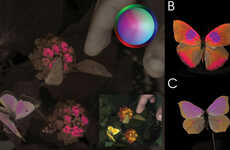
Hummingbirds Exposed on ‘Time Warp'
Sandra Winn — November 9, 2008 — Tech
References: dsc.discovery & youtube
The Discovery Channel’s newest show, ‘Time Warp,’ treated viewers to the inner workings of a hummingbird by combining high speed photography with x-ray photography. This is the first time such footage has ever been captured on tape.
‘Time Warp’ hosts Matt Kearney and Jeff Lieberman are obsessed with high-speed photography. Their drive, in the case of filming a hummingbird feeding, was to discover how exactly they do so while remaining stationary. High speed photography combined with x-ray photography allowed them to do so.
To my surprise, the biggest factor in a hummingbird’s ability to have their head remain stable while eating is the nectar. The nectar does not immediately go to their stomach, but rather a reserve tank between their shoulders and head. The fluid works as a pump for their wings and holds the hummingbird’s head still, allowing it to take in its sweet, delicious and nutritional food.
For those who may protest the hummingbird being the unwitting star of this ‘Time Warp’ segment, don’t worry, our fowl friend was captured humanely and x-ray exposure was minimal--or at least, so they say.
‘Time Warp’ hosts Matt Kearney and Jeff Lieberman are obsessed with high-speed photography. Their drive, in the case of filming a hummingbird feeding, was to discover how exactly they do so while remaining stationary. High speed photography combined with x-ray photography allowed them to do so.
To my surprise, the biggest factor in a hummingbird’s ability to have their head remain stable while eating is the nectar. The nectar does not immediately go to their stomach, but rather a reserve tank between their shoulders and head. The fluid works as a pump for their wings and holds the hummingbird’s head still, allowing it to take in its sweet, delicious and nutritional food.
For those who may protest the hummingbird being the unwitting star of this ‘Time Warp’ segment, don’t worry, our fowl friend was captured humanely and x-ray exposure was minimal--or at least, so they say.
Trend Themes
1. High-speed Photography - The combination of high-speed photography and x-ray photography provides new opportunities for capturing unseen moments and uncovering hidden processes.
2. X-ray Technology - Advancements in x-ray photography open up possibilities for non-invasive imaging and analysis in various fields.
3. Stabilization Techniques - Discovering and studying stabilization techniques used by hummingbirds can inspire innovative solutions for stability and balance in other industries.
Industry Implications
1. Media Production - The use of high-speed photography and x-ray imaging in media production offers captivating insights and storytelling opportunities.
2. Medical Imaging - The application of x-ray photography in medical imaging can revolutionize diagnostics and treatment planning with improved precision.
3. Engineering - Studying the stabilization techniques of hummingbirds can inform the development of lightweight and agile engineering solutions in industries such as robotics, aviation, and more.
3.9
Score
Popularity
Activity
Freshness























